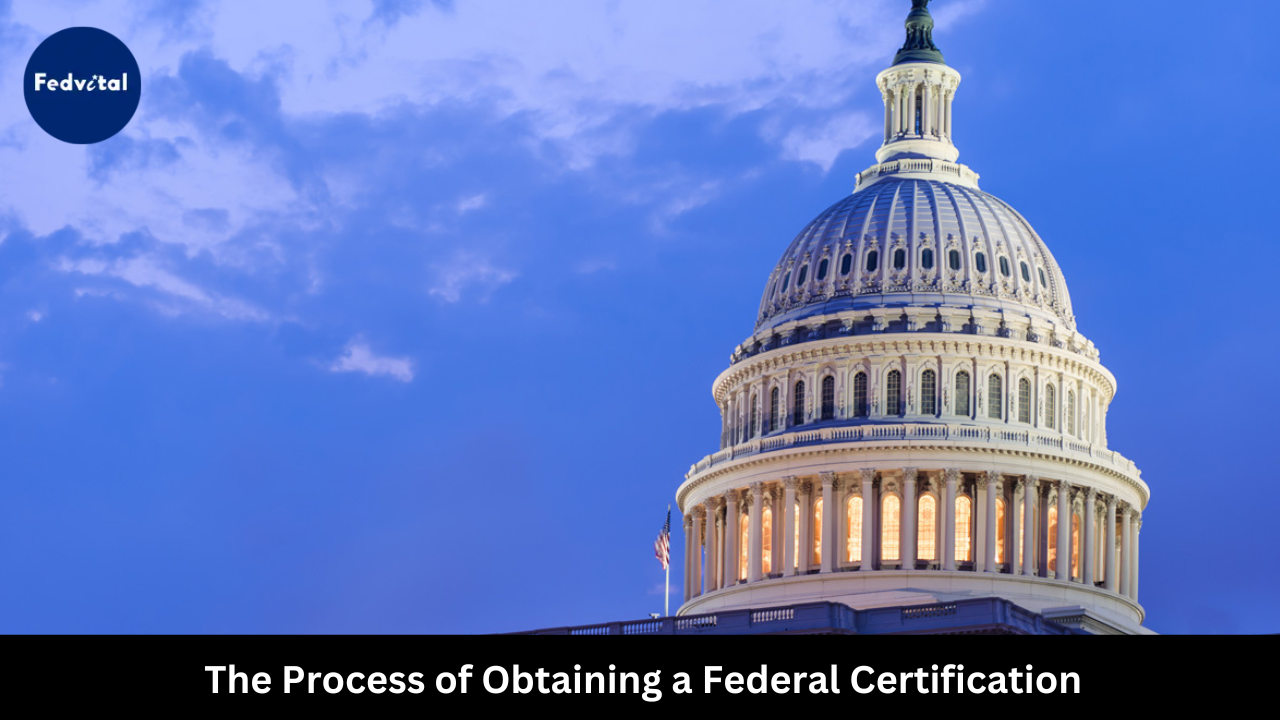In today’s competitive business landscape, obtaining federal certifications can be a game-changer for entrepreneurs and businesses aiming to secure government contracts. However, the process can often seem daunting, with numerous requirements, paperwork, and steps to navigate.
Fear not!
Here, today, in this comprehensive guide, we will walk you through the intricacies of obtaining a federal certification, demystifying the process, and empowering you to take the next step toward government contract success.
So, let’s get started!
Introduction: Breaking Down Federal Certifications
Before embarking on the intricacies of acquiring federal certifications, it’s essential to grasp their significance. Federal certifications, bestowed by government entities, validate that a business is helmed and managed by individuals from particular demographics or socioeconomic backgrounds.
These credentials play a pivotal role in fostering diversity, inclusion, and equitable access to government contracts. By recognizing and supporting businesses owned by women, minorities, veterans, and individuals with disabilities, federal certifications not only promote economic empowerment but also ensure a level playing field in government procurement.
The Process of Obtaining Federal Certification
They serve as a beacon of opportunity, empowering underrepresented groups to compete and thrive in the competitive landscape of government contracting. In essence, federal certifications are more than just credentials—they are instruments of progress, driving positive change and leveling the playing field for all.
Step 1: Identify Your Eligibility
The first crucial step in obtaining a federal certification is identifying your eligibility. Eligibility requirements for federal certifications vary depending on the type of certification sought, such as Minority-Owned Business Enterprise (MBE) or Women-Owned Small Business (WOSB).
These requirements typically include factors like ownership, size, and operational status. To determine eligibility, individuals or businesses can consult resources provided by relevant agencies like the Small Business Administration (SBA) or specific agency websites. However, misconceptions about eligibility often arise, such as believing that only certain industries qualify or that the application process is overly complicated.
In reality, many businesses may meet eligibility criteria without realizing it, and agencies often offer assistance to clarify requirements and guide applicants through the process. Therefore, it’s essential to research thoroughly and seek accurate information to ensure eligibility for federal certifications.
Also check our article on: Building A Federal Marketing Plan
Step 2: Choose the Right Certification Program
Once you have identified your eligibility, the next step is to choose the right certification program(s) for your business. There are several federal certification programs available, each catering to different demographic groups and business types. Some of the most common certification programs include:
- Women-Owned Small Business (WOSB) Certification: WOSB certification is available for businesses owned and controlled by women. It offers opportunities to compete for federal contracts set aside specifically for WOSBs in industries where women are underrepresented.
- Minority-Owned Business Enterprise (MBE) Certification: MBE certification is for businesses owned by individuals who are minorities, including African Americans, Hispanics, Asians, and Native Americans. It provides access to contracts aimed at promoting diversity in procurement.
- Veteran-Owned Small Business (VOSB) Certification: VOSB certification is for businesses owned and controlled by veterans. It enables participation in federal contracting programs designed to support veterans in business.
- Service-Disabled Veteran-Owned Small Business (SDVOSB) Certification: SDVOSB certification is specifically for businesses owned and operated by service-disabled veterans. It offers similar opportunities as VOSB certification but with additional preferences and advantages for disabled veterans.
- 8(a) Business Development Program Certification: The 8(a) certification is for small businesses owned by socially and economically disadvantaged individuals. It provides access to federal contracts, specialized business training, and assistance in accessing capital and business development resources.
Research each program thoroughly to determine which one aligns best with your business and goals. Keep in mind that you may qualify for multiple certifications, so explore all available options.
Step 3: Prepare Your Documentation
With your eligibility confirmed and certification program(s) selected, it is time to gather and prepare the necessary documentation. While the specific requirements may vary depending on the certification program, common documentation includes:
- Business formation documents (e.g., articles of incorporation, partnership agreements)
- Personal identification documents for business owners
- Financial statements and tax returns
- Proof of business ownership and control
- Any additional supporting documentation required by the certification program
Ensure that all documentation is accurate, up-to-date, and properly organized to streamline the application process.
Also read: Importance Of Niche Federal Marketing
Step 4: Submit Your Application
Once you have assembled all required documentation, it’s time to submit your application for federal certification. Navigating the application process for federal certification requires a systematic approach.
Firstly, understanding the step-by-step breakdown is essential. This typically involves tasks such as gathering required documentation, completing application forms, and submitting them to the relevant agency. Common forms and paperwork may include proof of ownership, financial statements, tax returns, and business plans, among others. Each certification may have specific documentation requirements, so thorough research is crucial.
To ensure accuracy and efficiency, applicants should pay close attention to detail when completing forms, double-checking all information for accuracy.
Additionally, organizing documents beforehand and following any provided guidelines can streamline the process. Seeking assistance from consultants or resources provided by certification agencies can also help navigate any complexities.
Lastly, maintaining communication with the agency throughout the process and promptly addressing any requests for additional information can expedite the application review process.
Step 5: Understanding Certification Agencies
Navigating the landscape of certification agencies is crucial for individuals or businesses seeking federal certification. Key agencies include the Small Business Administration (SBA), Department of Transportation, and others depending on the type of certification desired. Each agency has distinct processes and requirements for certification, which can vary significantly.
For instance, the SBA focuses on small business certifications, while the Department of Transportation may handle certifications related to transportation-related contracts. Choosing the right agency involves considering factors such as the industry you operate in, the type of certification needed, and the specific contracting opportunities you aim to pursue.
Researching each agency’s scope, expertise, and track record in certifying businesses within your sector can help you make an informed decision and streamline the certification process for your needs.
Step 6: Await Review and Approval
Once you have submitted your application, the certification agency undertakes a meticulous review of your documentation to ensure your eligibility aligns with the program’s requirements. This thorough scrutiny is imperative to maintain the integrity of the certification process.
Understandably, this review phase can span several weeks to even months, contingent upon factors such as the volume of applications and the intricacies of your case. While awaiting feedback, it is vital to remain patient and proactive. Stay attuned to any correspondence from the certification agency, promptly addressing any requests for supplementary information or clarification they may require.
By promptly responding and cooperating with the agency, you not only demonstrate your commitment but also expedite the review process. Additionally, maintaining open lines of communication fosters a positive relationship with the agency, potentially facilitating smoother interactions throughout the certification journey.
Step 7: Maintain Compliance
Congratulations! Upon approval, you will officially be certified under your chosen federal certification program(s). However, obtaining certification is just the beginning. It’s crucial to maintain compliance with program requirements to retain your certification status. This may include annual recertification, reporting requirements, and participation in program-related activities or initiatives.
NOTE:
“The Process of Obtaining a Federal Certification” is a comprehensive guide aimed at demystifying the intricate steps involved in securing federal certifications. Whether it’s obtaining a Woman-Owned Small Business (WOSB) certification, Service-Disabled Veteran-Owned Small Business (SDVOSB) certification, or any other federal designation, navigating the labyrinth of regulations can be daunting. Fedvital, your trusted federal marketing consultant, is your steadfast companion on this journey. With our expert guidance and in-depth knowledge of federal regulations, we streamline the certification process, ensuring compliance and maximizing your chances of success. Let Fedvital be your strategic partner in achieving federal certification and unlocking a world of opportunities in government contracting.
Conclusion: The Process of Obtaining Federal Certification
In conclusion, obtaining a federal certification can open doors of opportunity for your business, providing access to government contracts and procurement opportunities reserved for certified small businesses.
By following the step-by-step guide outlined above and staying informed about program requirements and updates, you can navigate the certification process with confidence and position your business for success in the federal marketplace.
Don’t let the complexities of certification deter you—embrace the process, seize the opportunity, and watch your business thrive in the world of government contracting.



